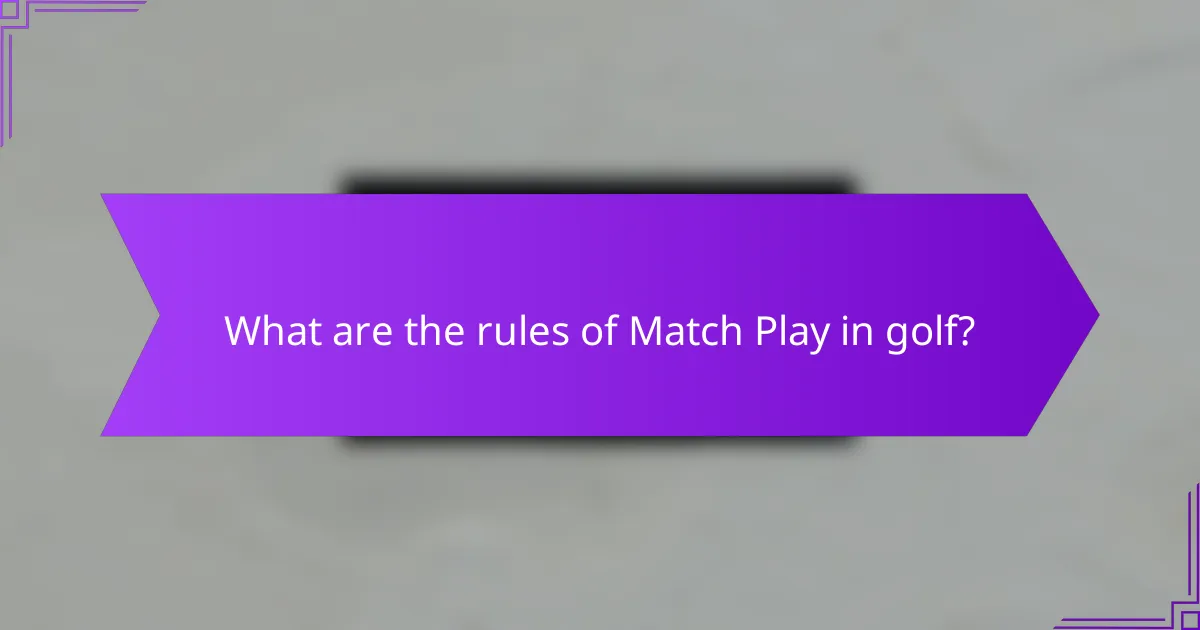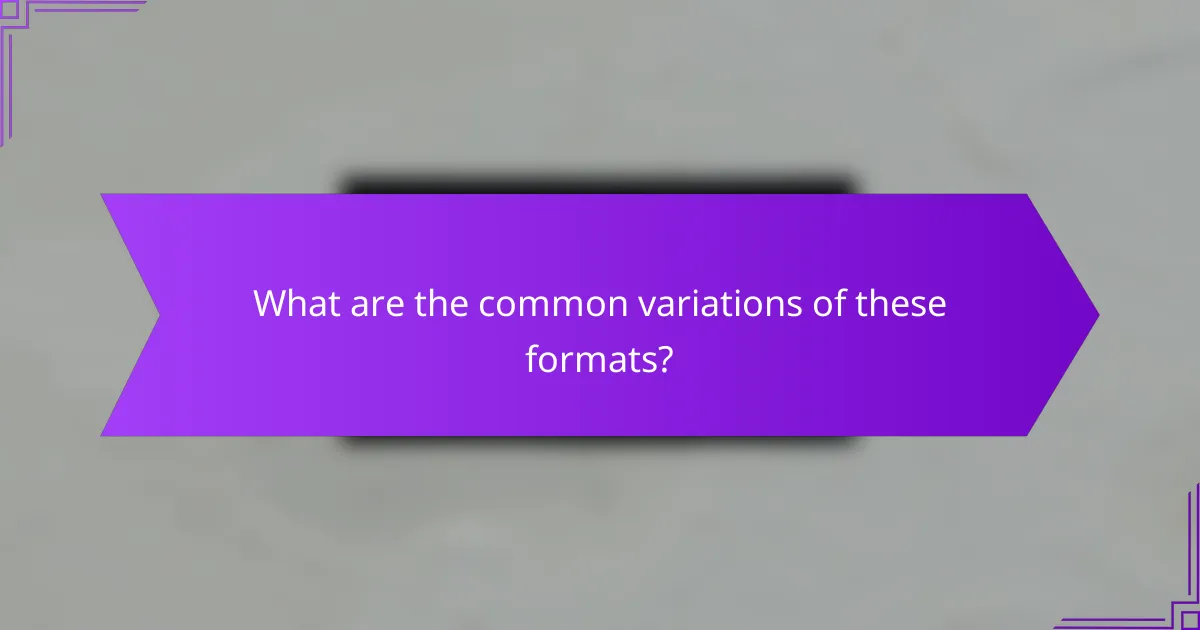Golf tournaments often feature three main formats: stroke play, match play, and scramble, each offering distinct rules and strategies. Stroke play focuses on completing the course in the fewest total strokes, while match play pits players against each other to win individual holes. The scramble format encourages teamwork, as players work together to achieve the best score by selecting the best shot from their group. Understanding these formats can enhance both participation and enjoyment in the game.

What are the popular golf tournament formats in the United States?
The most popular golf tournament formats in the United States include stroke play, match play, and scramble. Each format has unique rules and strategies that cater to different playing styles and competitive environments.
Stroke Play
Stroke play is the most common format in golf tournaments, where the total number of strokes taken over a specified number of holes determines the winner. Players aim to complete the course in the fewest strokes possible, with the total score being the primary measure of performance.
This format is straightforward and allows for a clear ranking of players based on their scores. It is often used in professional tournaments, including the PGA Tour and major championships, where players compete over 18 holes or more.
Match Play
In match play, players compete head-to-head, with the goal of winning individual holes rather than achieving the lowest total score. Each hole is worth one point, and the player who wins the most holes wins the match.
This format emphasizes strategy and can lead to more dynamic and exciting play, as players may take risks to win specific holes. Match play is commonly used in team competitions, such as the Ryder Cup, where players represent their countries or clubs.
Scramble
The scramble format is often used in casual tournaments and charity events, where teams of players work together to achieve the best score. Each player on the team hits a tee shot, and the team then selects the best shot to play from, repeating this process until the hole is completed.
This format encourages teamwork and is suitable for players of varying skill levels, making it a popular choice for social gatherings. Scrambles typically have a relaxed atmosphere and can include fun variations, such as themed events or challenges to enhance the experience.

How does Stroke Play work in golf tournaments?
Stroke play is a popular format in golf tournaments where the objective is to complete the course in the fewest total strokes. Each player counts the number of strokes taken on each hole, and the player with the lowest overall score at the end of the round wins.
Scoring based on total strokes
In stroke play, every stroke counts, including penalties and missed putts. Players keep track of their scores on each hole, and the total is summed at the end of the round. For example, if a player scores 4 on the first hole, 5 on the second, and 3 on the third, their total score would be 12 strokes for those three holes.
It’s essential for players to accurately record their scores, as discrepancies can lead to disqualification. Most tournaments require players to submit their scorecards at the end of the round for verification.
Common in professional events
Stroke play is the standard format used in many professional golf tournaments, including major championships like The Masters and the U.S. Open. This format allows for clear rankings and is straightforward for spectators to follow, as the lowest score wins.
In professional events, players often compete over several rounds, typically four, with the cumulative score determining the champion. This format emphasizes consistency and skill over a single match, making it a true test of a golfer’s abilities.

What are the rules of Match Play in golf?
Match play in golf is a format where two players or teams compete against each other, with the objective of winning individual holes rather than accumulating the lowest total strokes. Each hole is won by the player or team that takes the fewest strokes to complete it, and the overall winner is determined by who wins the most holes.
Head-to-head competition
In match play, the competition is directly between two players or teams, making it a more strategic format. Players can focus on their opponent’s performance, adjusting their tactics based on how many holes they are ahead or behind. This head-to-head nature often leads to more intense and engaging matches.
For example, if Player A is 2 up with 3 holes to play, they only need to win one more hole to secure victory, while Player B must win all remaining holes to win the match. This dynamic can change the approach each player takes on the course.
Winning holes instead of total strokes
In match play, the focus is on winning individual holes rather than accumulating the lowest overall score. A player wins a hole by completing it in fewer strokes than their opponent. If both players take the same number of strokes, the hole is halved, and neither player wins it.
This format allows for more aggressive play, as players can take risks to win a hole without worrying about the cumulative score. For instance, a player trailing by a hole may choose to go for a difficult shot to try to win the next hole, knowing that their overall score is less relevant in this context.

What is a Scramble format in golf tournaments?
A Scramble format in golf tournaments is a team-based competition where players work together to achieve the best score. Each player hits a tee shot, and the team selects the best shot to play from, continuing this process until the ball is holed.
Team-based play
In a Scramble, teams typically consist of two to four players. This collaborative approach allows participants to support each other by choosing the most advantageous shots, which can lead to lower scores compared to individual formats. Team dynamics can significantly influence performance, as communication and strategy are key components.
For example, a team of four might choose the best drive from one player, then each member plays their second shot from that location. This method encourages camaraderie and can make the game more enjoyable for players of varying skill levels.
Best shot selection
Best shot selection is crucial in a Scramble format. After each player tees off, the team evaluates the results and decides which shot offers the best opportunity for success. Factors to consider include distance to the hole, obstacles, and lie conditions.
To maximize scoring potential, teams should assess each player’s strengths. For instance, if one player excels at long drives while another is skilled with short game shots, the team can leverage these strengths to improve their overall performance. This strategic selection process is what makes Scrambles both competitive and fun.

How to choose the right tournament format for your event?
Selecting the appropriate tournament format for your golf event is crucial for ensuring player engagement and satisfaction. Consider factors such as player skill levels and the overall goals of the event to make an informed choice.
Consider player skill levels
Understanding the skill levels of your participants is essential when choosing a tournament format. For example, stroke play is often best for more experienced players, as it emphasizes individual performance over time. In contrast, match play can be more enjoyable for beginners, as it allows them to compete hole by hole without the pressure of overall scores.
To gauge skill levels, consider conducting a brief survey or using past performance data. This will help you group players effectively and choose a format that matches their abilities, ensuring a more competitive and enjoyable experience for everyone involved.
Evaluate event goals
Your event’s objectives should heavily influence the tournament format you select. If the goal is to foster camaraderie and teamwork, a scramble format might be ideal, as it encourages collaboration among players. Alternatively, if the aim is to crown a champion, stroke play or match play formats may be more appropriate.
Additionally, consider whether the event is meant to be casual or competitive. For a fun, social gathering, a relaxed scramble can enhance enjoyment, while a more serious tournament may benefit from the structure of stroke play. Aligning the format with your goals will enhance the overall experience for participants.

What are the benefits of each golf tournament format?
Each golf tournament format offers unique advantages that cater to different player preferences and competitive styles. Understanding these benefits can help players choose the format that best suits their skills and goals.
Stroke Play promotes individual skill
Stroke play is a format where players compete to complete the course in the fewest total strokes. This format emphasizes individual performance, allowing players to showcase their skills over the entire round.
In stroke play, each stroke counts, and players must manage their game strategically, including shot selection and course management. This format is commonly used in professional tournaments, making it a standard for measuring skill levels.
Match Play enhances competition
Match play involves head-to-head competition where players or teams compete to win individual holes rather than focusing on the total strokes. This format creates a more dynamic and competitive atmosphere, as players can take risks to win specific holes.
In match play, the outcome of each hole can shift momentum, making it thrilling for both players and spectators. This format is popular in amateur events and team competitions, such as the Ryder Cup, where strategy and psychological tactics play a significant role.
Scramble encourages teamwork
The scramble format is a team-based competition where each player hits a tee shot, and the team selects the best shot to play from next. This collaborative approach fosters teamwork and camaraderie among players.
Scrambles are often used in charity events and casual tournaments, making them accessible for players of all skill levels. Teams can combine their strengths, allowing less experienced players to contribute while benefiting from the skills of more proficient teammates.

What are the common variations of these formats?
The common variations of golf tournament formats include Modified Stableford and Four-ball. Each format has unique scoring methods and strategies that can influence gameplay and team dynamics.
Modified Stableford
The Modified Stableford format awards points based on the number of strokes taken on each hole, encouraging aggressive play. Players earn points for birdies, eagles, and pars, while losing points for bogeys and worse. This system can lead to higher scores and more excitement, as players aim to maximize their point totals.
For example, a player might earn 5 points for an eagle, 2 points for a birdie, and lose 1 point for a bogey. This format is popular in various tournaments, particularly in the United States, as it allows for a more dynamic and engaging competition.
Four-ball
In the Four-ball format, two teams of two players each compete, with each player playing their own ball. The best score from each team on a hole is used to determine the team’s score for that hole. This format emphasizes teamwork and strategy, as players can support each other while also competing individually.
For instance, if one player scores a par and their partner scores a birdie, the team will take the birdie score for that hole. Four-ball is commonly used in team competitions, such as the Ryder Cup, and can create thrilling matchups as players strive to outscore their opponents.



